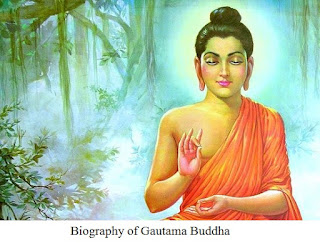Biography of Gautama Buddha
Gautama Buddha, also known as Siddhartha Gautama, was a spiritual teacher and religious leader who lived in ancient India. He is the central figure in Buddhism, a major world religion and philosophical tradition. Gautama Buddha’s life and teachings laid the foundation for the Buddhist faith, emphasizing the Four Noble Truths and the Eightfold Path, which guide followers on the path to enlightenment and liberation from suffering.
 |
| Biography of Gautama Buddha |
Early Life:
Gautama Buddha was born around 563 BCE (the exact date is uncertain) in Lumbini, a region in present-day Nepal. He was born into a wealthy family of the Kshatriya (warrior) caste. His father, King Suddhodana, sheltered him from the harsh realities of life, hoping to make him a great king.
The Four Sights and Renunciation:
Despite the luxury of his upbringing, Siddhartha was deeply troubled by the sufferings he witnessed. During his late twenties, he encountered what are known as the Four Sights: an old man, a sick person, a corpse, and a wandering ascetic. These encounters made him ponder the nature of human existence, suffering, and death.
Disturbed by the impermanence and suffering in the world, Siddhartha decided to renounce his privileged life and seek spiritual enlightenment. He left his palace, wife, and son, embarking on a journey of self-discovery and asceticism.
Enlightenment and Teachings:
After years of intense meditation and self-mortification, Siddhartha Gautama attained enlightenment, or Nirvana, at the age of 35. This profound realization occurred under the Bodhi tree in Bodh Gaya, Bihar, India. He spent the rest of his life traveling and teaching, gathering disciples and followers along the way.
Gautama Buddha’s teachings revolved around the Four Noble Truths:
1. The Truth of Suffering (Dukkha): Life is filled with suffering and dissatisfaction.
2. The Truth of the Cause of Suffering (Samudaya): Attachment and desire cause suffering.
3. The Truth of the End of Suffering (Nirodha): Suffering can be ended by letting go of attachment and desire.
4. The Truth of the Path to the End of Suffering (Magga): Following the Eightfold Path leads to the cessation of suffering.
Spread of Buddhism:
Buddha’s teachings gained followers rapidly, and Buddhism spread throughout ancient India and eventually to other parts of Asia. After his death, known as Mahaparinirvana, his disciples and followers continued to spread his teachings and established monastic communities.
Legacy:
Gautama Buddha’s legacy lives on in Buddhism, which has become one of the world’s major religions. His teachings have inspired countless individuals on their spiritual journeys, emphasizing compassion, mindfulness, and the pursuit of enlightenment. Buddhist communities around the world continue to follow his path, seeking understanding, inner peace, and liberation from the cycle of suffering.